Samut Prakan, on the Chao Phraya River delta in Thailand, is a paradise for birdwatchers. The province boasts a wide variety of bird species, with over 200 species recorded.
Many of the birds here are migratory, with some coming from as far away as Siberia and Northern China. The wetlands, mangroves, and agricultural areas attract a variety of birds.
The coastal areas are home to a number of wading bird species and the inland areas to a variety of woodland and grassland birds.
There are also a number of threatened and endangered species living in the area, including the Oriental Darter, Grey-headed Fish Eagle, and the White-rumped Vulture. With its diverse bird population, it is no surprise that Samut Prakan is a great destination for birdwatching.
1. Red-Whiskered Bulbul
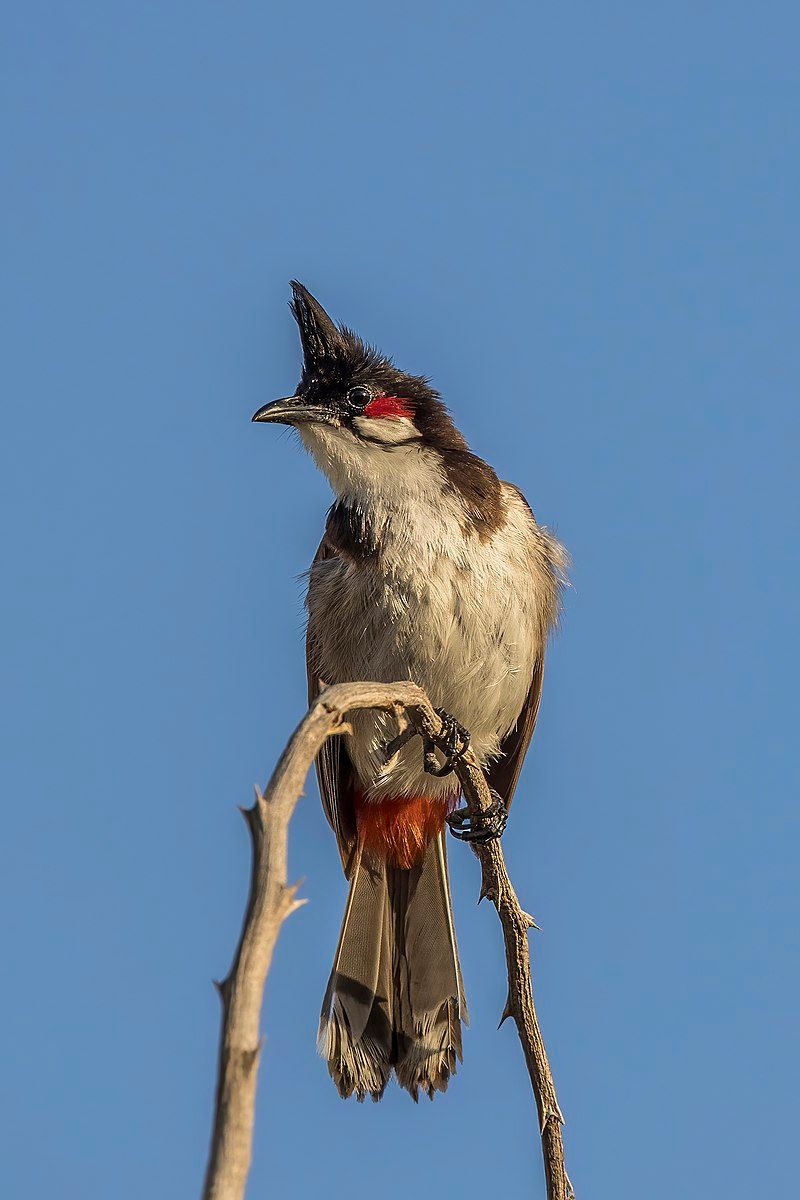
The red-whiskered bulbul is a passerine bird, meaning it belongs to the order of birds that are perching. It is a member of the Bulbul family, which is a group of medium-sized songbirds found mainly in Africa and Asia.
It is a resident frugivore, meaning it feeds mostly on fruit and can be found in tropical areas of Asia. This bird has been introduced to other tropical regions of the world, and in some cases, the bird has managed to establish a presence.
The red-whiskered bulbul is known for its distinctive red feathers around its cheeks, giving it an easily identifiable look. It is an active bird, often seen hopping around in groups, foraging for food and making its characteristic calls.
| Kingdom | Animalia |
| Phylum | Chordata |
| Class | Aves |
| Order | Passeriformes |
| Family | Pycnonotidae |
| Genus | Pycnonotus |
| Species | P. jocosus |
2. Brahminy Kite
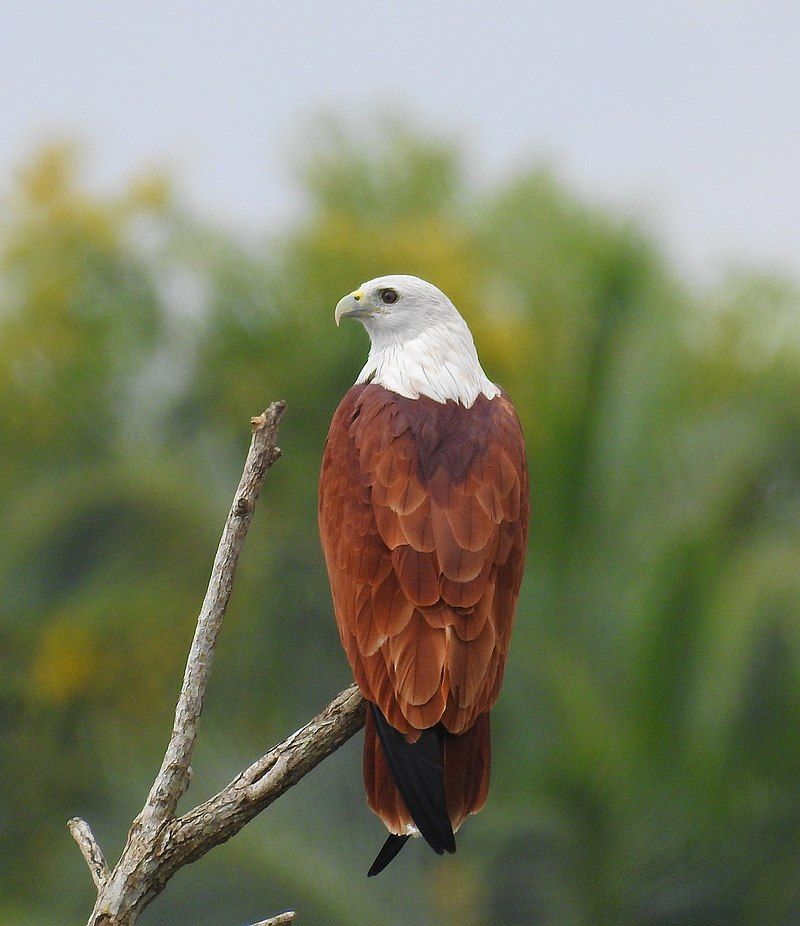
The Brahminy Kite is a bird of prey that belongs to the Accipitridae family, which contains many diurnal raptors such as eagles, buzzards, and harriers.
This species of bird is widely distributed, with its range spanning from the Indian subcontinent, to Southeast Asia, and even Australia, where it is known as the Red-Backed Sea-Eagle.
It is a medium-sized raptor, with adults typically measuring between 55 and 65 cm in length, and boasting impressive wingspans of up to 1.4 metres. The Brahminy Kite is mainly found near coasts and rivers and is a highly adaptable species.
It is predominantly a scavenger, feeding on carrion, offal, and discarded fish. It also feeds on small rodents, reptiles, amphibians, and even insects. During the breeding season, this species of raptor can be seen nesting in tall trees, often near water.
The Brahminy Kite is a protected species in many countries, due to its declining population. This is mainly caused by the destruction of its coastal habitats, as well as the introduction of new predators, such as the feral cat.
Despite these threats, this species of bird is still quite common in some areas, and is a fascinating creature to observe.
| Kingdom | Animalia |
| Phylum | Chordata |
| Class | Aves |
| Order | Accipitriformes |
| Family | Accipitridae |
| Genus | Haliastur |
| Species | H. indus |
3. Spotted Redshank
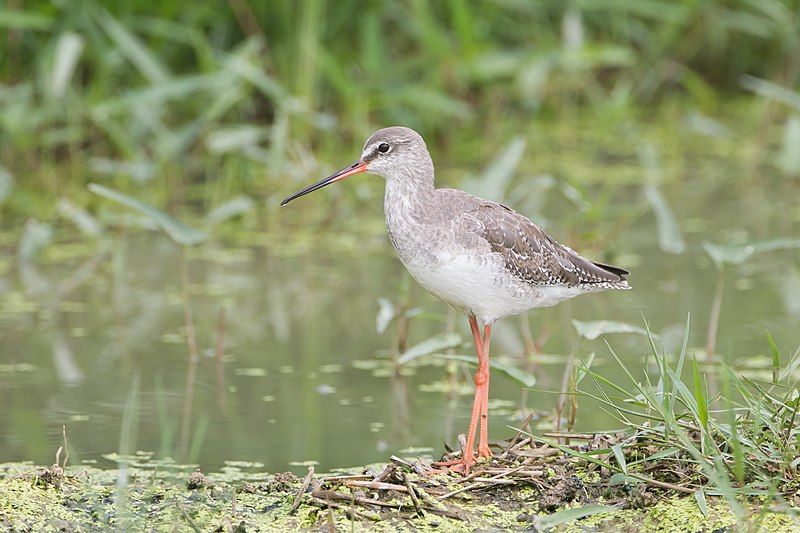
The spotted redshank is a species of wader bird that is part of the Scolopacidae family, which is a large family of birds that includes sandpipers, woodcocks, curlews, snipes, and phalaropes.
It is also known as Tringa, which is a Neo-Latin name given to the green sandpiper by Aldrovandus in 1599. This name was derived from the Ancient Greek trungas, which was a type of white-rumped, thrush-sized, tail-bobbing wading bird mentioned by Aristotle.
The spotted redshank is a large migratory bird that is found in coastal areas of Europe, Africa, and Asia. It has a mottled black and white plumage, a long, thin, red bill, and long, red-brown legs with white spots.
It is often seen foraging for food in shallow water and mudflats, as well as on beaches and meadows. It feeds mainly on insects, crustaceans, mollusks, and worms.
| Kingdom | Animalia |
| Phylum | Chordata |
| Class | Aves |
| Order | Charadriiformes |
| Family | Scolopacidae |
| Genus | Tringa |
| Species | T. erythropus |
4. Ashy Drongo
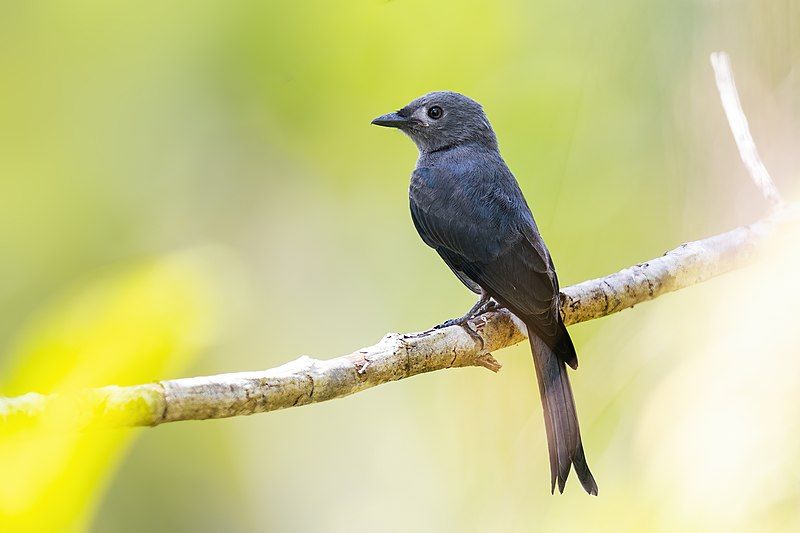
The ashy drongo is a species of bird that belongs to the family of Dicruridae.
It is widely distributed across South and Southeast Asia, with various populations that are differentiated by the colour of their plumage which ranges from light grey to dark grey, as well as their migration patterns and the size or presence of white patches around the eyes.
This species of drongo is a fairly adaptable bird, which is why it is able to occupy such a wide range of habitats and climates.
The ashy drongo is also an opportunistic species, meaning that it can take advantage of a variety of food sources, including insects, small mammals, and fruits. This makes them extremely versatile and able to survive in a wide range of environments.
In addition, due to their relatively wide geographical range, they are capable of migrating to different areas when food sources become scarce or when seasonal changes occur.
In conclusion, the ashy drongo is a highly adaptable bird that is found across South and Southeast Asia and can survive in a variety of climates and habitats.
| Kingdom | Animalia |
| Phylum | Chordata |
| Class | Aves |
| Order | Passeriformes |
| Family | Dicruridae |
| Genus | Dicrurus |
| Species | D. leucophaeus |
5. Asian Brown Flycatcher
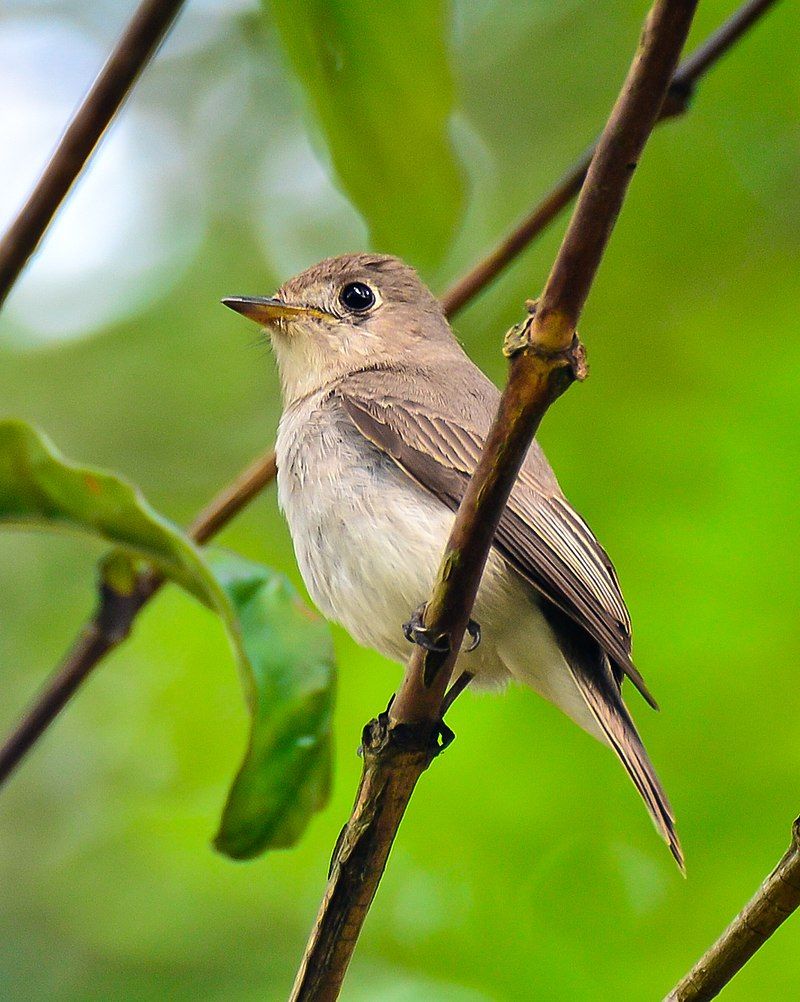
The Asian brown flycatcher is a small passerine bird that belongs to the family Muscicapidae. Muscicapidae is derived from the Latin words musca, meaning fly, and capere, meaning to catch. This implies that the family of birds is specialized in catching flies.
The specific dauurica refers to Dauria, which is an area located in south-eastern Siberia. The region was named after a nomadic tribe that lived in the area, and the bird was likely named after the region as well.
The Asian brown flycatcher is a common species of flycatcher in the area and is known for its distinctive brown feathering. The bird is an important part of the local ecosystem, as it helps to control the population of flies.
By doing so it helps to maintain a healthy balance in the environment.
| Kingdom | Animalia |
| Phylum | Chordata |
| Class | Aves |
| Order | Passeriformes |
| Family | Muscicapidae |
| Genus | Muscicapa |
| Species | M. dauurica |
6. Verditer Flycatcher
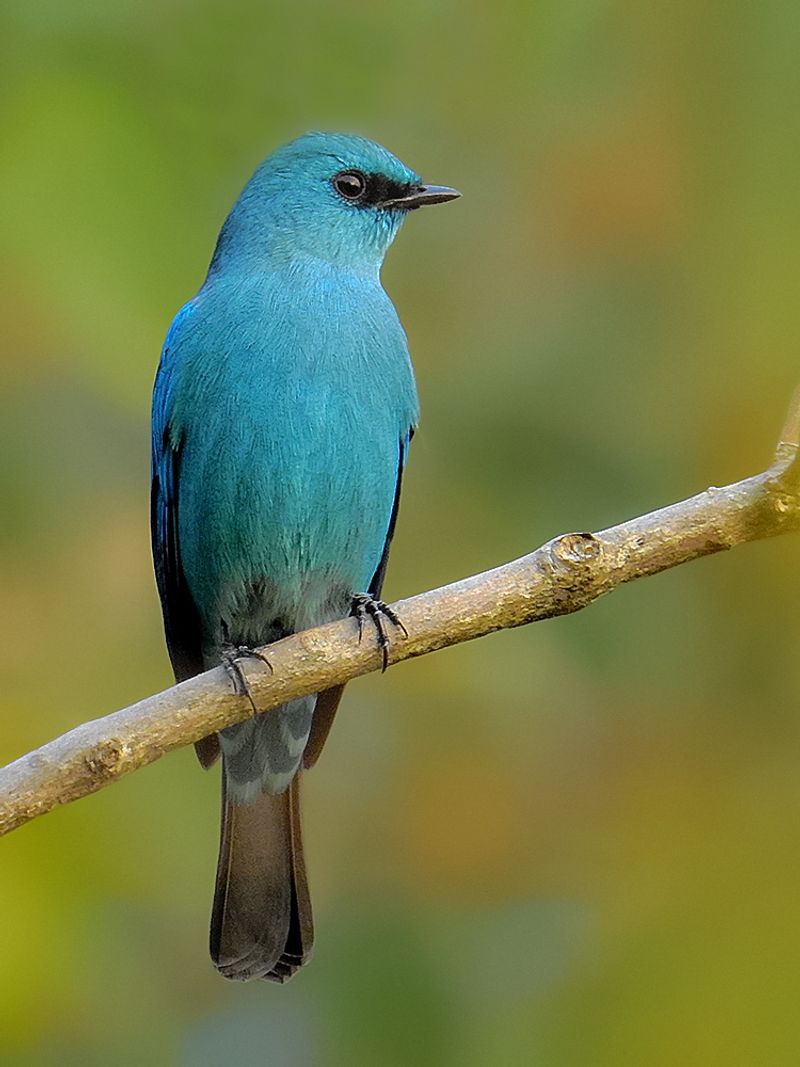
The verditer flycatcher is a species of Old World flycatcher, a type of songbird found in the Himalayan Mountains, Southeast Asia, and Sumatra.
It is named after its unique shade of copper-sulphate blue feathers and has a dark patch of feathers between its eyes and above its bill. This species is a medium-sized bird, measuring up to 6.7 inches in length and weighing up to 1.4 ounces.
It has a long, slender beak and a short, rounded tail. The verditer flycatcher is an active forager, hunting small insects in the air or on the ground. It has a song that is composed of a series of rapid trills and twitters, often repeated several times.
It builds its nest out of plant fibers, moss, and other small materials, usually near water sources. This species is fairly common in its range, but its population is declining due to habitat loss and degradation.
Conservation efforts are needed to ensure the future of the verditer flycatcher.
| Kingdom | Animalia |
| Phylum | Chordata |
| Class | Aves |
| Order | Passeriformes |
| Family | Muscicapidae |
| Genus | Eumyias |
| Species | E. thalassinus |
7. Terek Sandpiper

The Terek sandpiper is a species of small wader, a type of bird found in the Palearctic region. It is the only species in its genus, Xenus, and is named after the Terek River which flows into the west of the Caspian Sea.
This species was first observed in this area, making it unique to this region. The Terek sandpiper is a migratory species, meaning it spends part of the year living in warmer climates, and part of the year living in colder climates.
This species is fairly small, ranging from 16-18 cm in length, and has a wingspan of 33-38 cm. It has a grey-brown back and wings, with a white underside and a pale yellow neck.
The legs are yellowish-green and the bill is long and thin. This species feeds on small insects, crustaceans, and molluscs. It can usually be found foraging in shallow waters, as it prefers wetland habitats.
The Terek sandpiper breeds in Eurasia during the summer months, and migrates to Africa during the winter. Overall, the Terek sandpiper is a unique species of wader found in the Palearctic region.
It is the only species in its genus and was first identified in the area around the Terek River. This species is migratory, spending part of the year breeding in Eurasia and part of the year migrating to Africa.
It feeds on small insects, crustaceans, and molluscs, and can usually be found foraging in shallow waters.
| Kingdom | Animalia |
| Phylum | Chordata |
| Class | Aves |
| Order | Charadriiformes |
| Family | Scolopacidae |
| Genus | Xenus |
| Species | X. cinereus |
8. Striated Heron
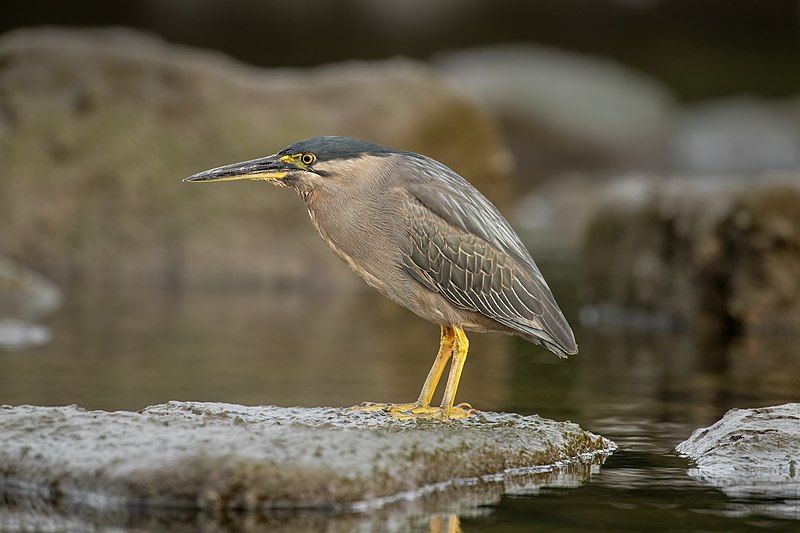
The Striated Heron, also known as the Mangrove Heron, Little Green Heron, or Green-Backed Heron, is a small bird species. It typically grows to a height of about 44 centimeters. Striated Herons are mostly sedentary, meaning they don’t migrate.
They tend to stay in the same area throughout the year. This species of heron is known for its interesting behaviors. For example, they are often seen standing very still and waiting in one spot for several minutes.
They do this in order to catch their prey, which is usually small fish and insects. They also have been seen using their bills to probe for food in the mud. The Striated Heron also has a unique way of preening itself.
It uses its beak to reach all the way around its body to preen its feathers. This behavior helps keep the bird’s feathers in good condition. The Striated Heron is an interesting species of bird. It has unique behaviors, and it is mostly sedentary.
By understanding the Striated Heron, we can learn more about how different species of birds live and interact with their environment.
| Kingdom | Animalia |
| Phylum | Chordata |
| Class | Aves |
| Order | Pelecaniformes |
| Family | Ardeidae |
| Genus | Butorides |
| Species | B. striata |
9. Black-Naped Oriole
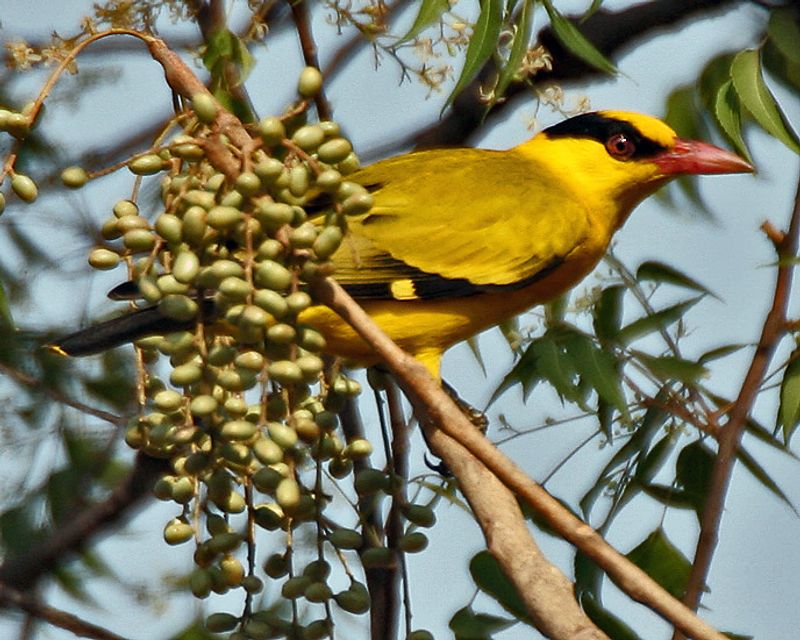
The black-naped oriole (Oriolus chinensis) is a passerine bird belonging to the Oriolidae family. It is widely distributed throughout much of Asia, with various distinctive populations occurring in different regions.
In the past, the slender-billed oriole (Oriolus tenuirostris) was considered a subspecies of the black-naped oriole, but it is now considered a separate species. The black-naped oriole is a medium-sized songbird with a bright yellow body and a black nape.
Its wings and tail are black, with white edges. It has a pointed bill and long legs. Its call is a loud, ringing whistle. The black-naped oriole is found in forests, woodland, orchards, and cultivated areas. It feeds on insects, fruits, berries, and nectar.
It is a social species, often seen in pairs or small flocks. It is also quite vocal, with a variety of different calls and songs. The black-naped oriole is widely distributed across much of Asia, including India, Sri Lanka, Bangladesh, China, Thailand, and Malaysia.
There are several distinct populations within this wide range, and in the past, the slender-billed oriole was included as a subspecies.
However, genetic and anatomical evidence suggests that the two species are not closely related, and the slender-billed oriole is now considered a separate species.
| Kingdom | Animalia |
| Phylum | Chordata |
| Class | Aves |
| Order | Passeriformes |
| Family | Oriolidae |
| Genus | Oriolus |
| Species | O. chinensis |
10. Tiger Shrike
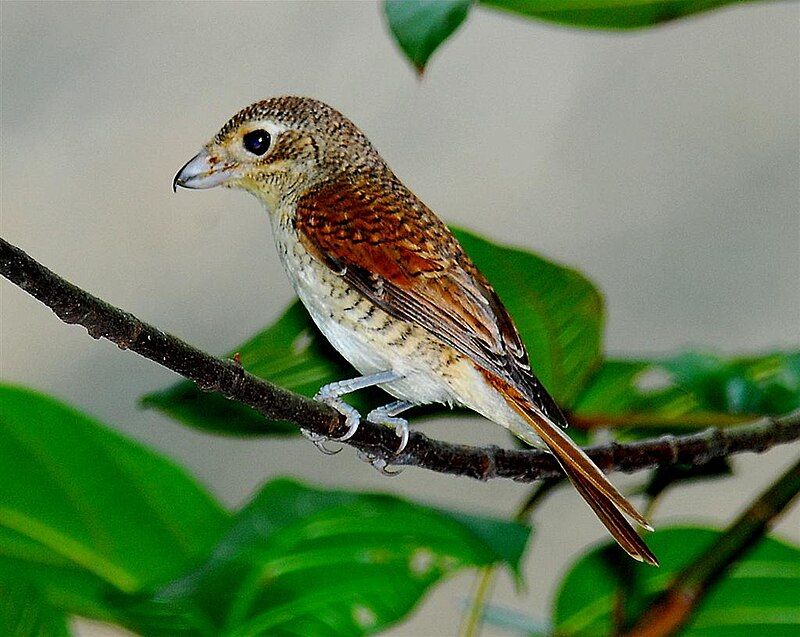
The tiger shrike, also known as the thick-billed shrike, is a small species of passerine bird that is part of the shrike family, Laniidae. This bird is found in wooded areas throughout eastern Asia.
This species is a shy, solitary bird, and therefore much less noticeable than other shrikes. The tiger shrike is usually found perched on a branch, or in shrubs and trees, quietly searching for its prey. It feeds on insects, lizards, small mammals, and other small birds.
This species is known for its habit of impaling its prey on thorns or barbed wire, a behavior that has earned it the nickname “butcherbird”. The tiger shrike is a beautiful bird, with a white chest and underparts, and a black and white striped back and wings.
The head and face are black, with a white stripe above the eye, and a white patch on the cheek. It also has a long, hooked bill and yellow eyes. The tiger shrike is a fascinating bird, and its behavior is an interesting sight to observe.
| Kingdom | Animalia |
| Phylum | Chordata |
| Class | Aves |
| Order | Passeriformes |
| Family | Laniidae |
| Genus | Lanius |
| Species | L. tigrinus |
11. Purple Heron
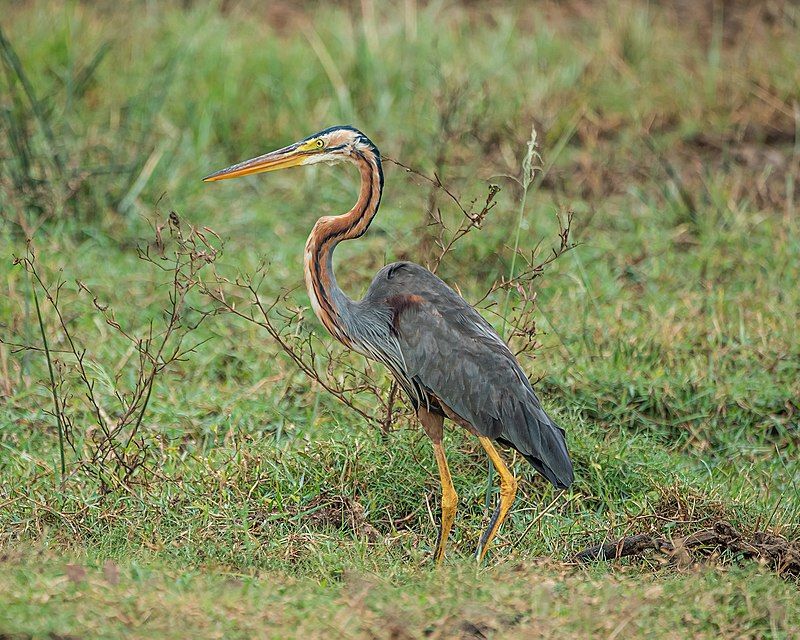
The purple heron is a type of wading bird that belongs to the heron family, Ardeidae. Its scientific name is derived from the Latin words ardea, which means “heron”, and purpureus, which means “coloured purple”.
This species of heron is found in a wide range of habitats, ranging from Africa to central and southern Europe, as well as southern and eastern Asia. The purple heron is known for its unique coloration, which is a deep, iridescent purple.
It is also known for its solitary, secretive nature, often nesting in thick foliage near water sources. During the breeding season, the purple heron will build large, bulky nests from sticks and twigs, which are often placed high in the trees.
The heron will then lay a clutch of two to four eggs, which are white in color. Once the chicks have hatched, the parents will care for them until they are ready to leave the nest.
| Kingdom | Animalia |
| Phylum | Chordata |
| Class | Aves |
| Order | Pelecaniformes |
| Family | Ardeidae |
| Genus | Ardea |
| Species | A. purpurea |
12. Paddyfield Pipit
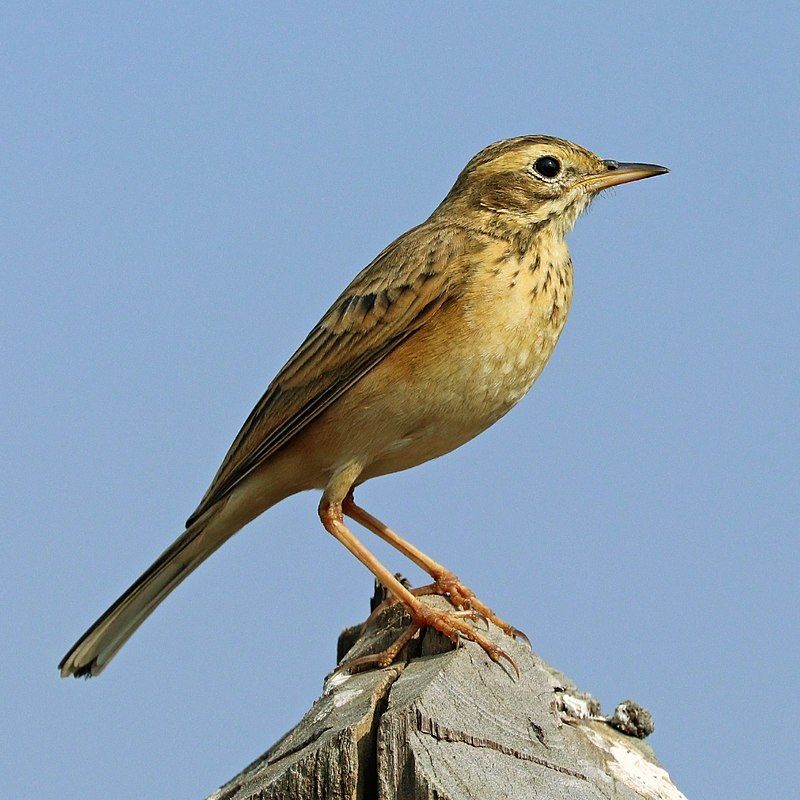
The Paddyfield Pipit, also known as the Oriental Pipit, is a small, passerine bird that belongs to the Pipit and Wagtail family. It is a migratory bird that breeds in the open scrub, grasslands, and cultivated areas of southern Asia, extending east to the Philippines.
These birds have a wide range of habitats and can be found in meadows, marshes, farmland, grasslands, and even urban areas. The Paddyfield Pipit is a small, brown bird with streaked upperparts, a white, yellow, or buff-colored underbelly, and a slender bill.
It has a large head with a distinctive crest, which gives the bird a more upright posture. The Paddyfield Pipit is usually seen foraging on the ground for small invertebrates and in the air for flying insects.
It also has a distinctive call, a soft, melodious “pipit”.The Paddyfield Pipit breeds from March to June and has two broods each year. The female lays three to five eggs at a time and incubates them for about two weeks.
The chicks are usually cared for and fed by both parents, and the fledgling period lasts about two weeks. The Paddyfield Pipit is a common bird in many parts of southern Asia, but it is threatened by habitat destruction and fragmentation due to agricultural expansion and urbanization.
Despite this, this species remains fairly common and widespread in its rang.
| Kingdom | Animalia |
| Phylum | Chordata |
| Class | Aves |
| Order | Passeriformes |
| Family | Motacillidae |
| Genus | Anthus |
| Species | A. rufulus |
13. Brown Shrike
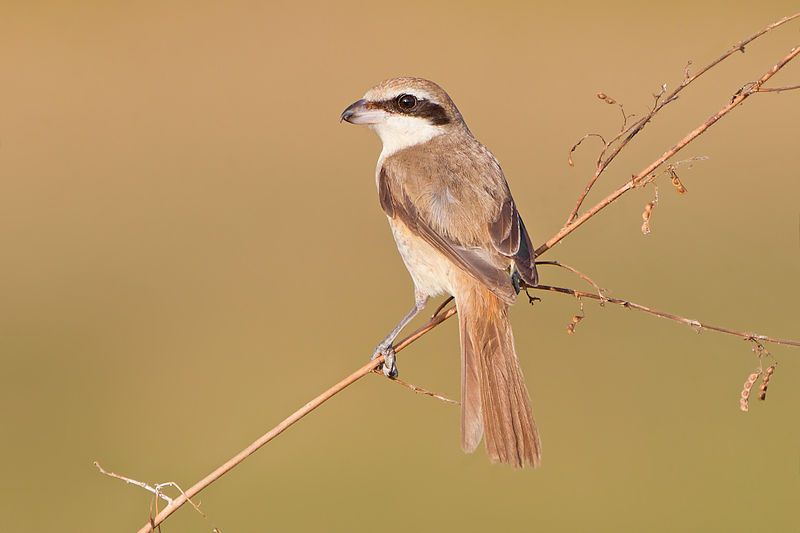
The brown shrike is a species of bird that can be found mainly in Asia and is part of the shrike family. This bird is closely related to two other species of shrikes, the red-backed shrike and the isabelline shrike.
The genus for the brown shrike is Lanius, which is derived from the Latin word for “butcher”. This is because some species of shrike are also known as “butcher birds” due to their particular feeding habits.
The brown shrike is known to hunt other small animals and then impale them on thorns or barbed wire. This is a behavior that is common among most species of shrike, and it is this which has earned them the nickname “butcher birds”.
| Kingdom | Animalia |
| Phylum | Chordata |
| Class | Aves |
| Order | Passeriformes |
| Family | Laniidae |
| Genus | Lanius |
| Species | L. cristatus |
14. Little Ringed Plover
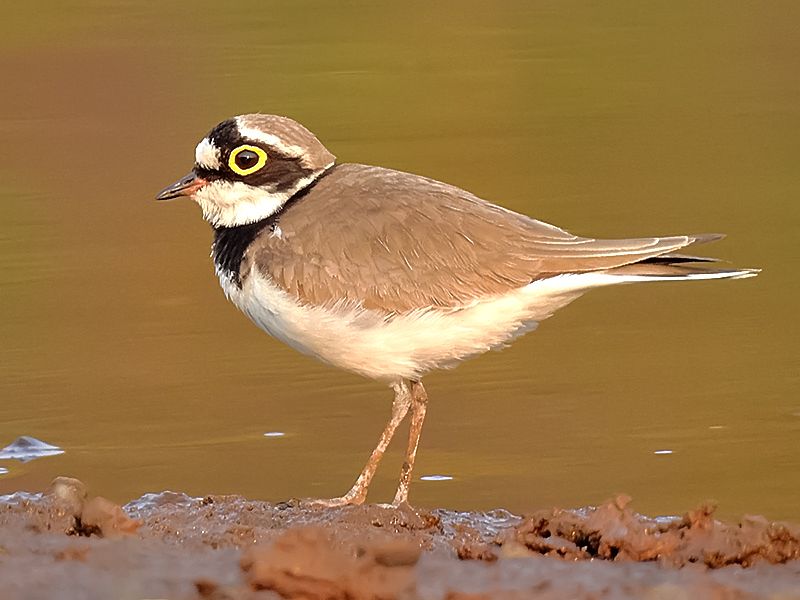
The little ringed plover is a bird belonging to the plover family. It is a small bird typically found in grassy areas, such as meadows, marshes, and fields.
The name of the genus of the little ringed plover, Charadrius, is taken from a Late Latin word that is used to describe a yellowish bird that is mentioned in the fourth-century Vulgate. The Vulgate is an early version of the Bible.
The Latin word itself is derived from the Ancient Greek term kharadrios, which was used to describe a bird that was found in river valleys. This type of bird is commonly known as a wading bird, as they are typically seen in shallow waters, such as the edges of rivers or lakes.
The little-ringed plover is an important species of bird and is commonly used by researchers to study the effects of human activities on the environment.
| Kingdom | Animalia |
| Phylum | Chordata |
| Class | Aves |
| Order | Charadriiformes |
| Family | Charadriidae |
| Genus | Charadrius |
| Species | C. dubius |
15. Kentish Plover
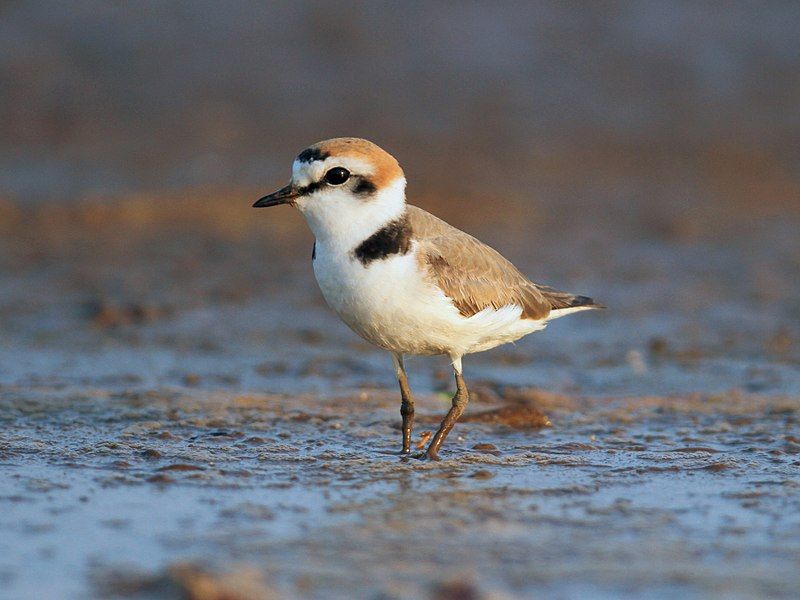
The Kentish plover is a type of shorebird belonging to the family Charadriidae, which consists of many species of wading birds such as sandpipers, plovers, and oystercatchers.
It is a small bird with a cosmopolitan distribution, meaning that it can be found in many different parts of the world.
It reproduces and breeds in a variety of habitats, including the shores of saline lakes, lagoons, and coasts, as well as in sand dunes, marshes, semi-arid deserts, and tundra.
The Kentish plover is well adapted to its various habitats, and its diet consists of small insects and other invertebrates. During the breeding season, the plover will build nests on the ground and lay up to four eggs.
Its plumage is typically light brown, with darker brown, black, and white markings on its back, wings, and head.
Its wings are short and rounded, perfect for its habit of running along the shoreline. The Kentish plover has been classified as a species of least concern on the IUCN Red List due to its widespread distribution and large population size.
Despite this, some populations are still threatened due to habitat destruction, climate change, and overgrazing. Conservation efforts, such as the establishment of protected areas, are important in preserving this species and its habitat.
| Kingdom | Animalia |
| Phylum | Chordata |
| Class | Aves |
| Order | Charadriiformes |
| Family | Charadriidae |
| Genus | Charadrius |
| Species | C. alexandrinus |
16. Pacific Golden Plover
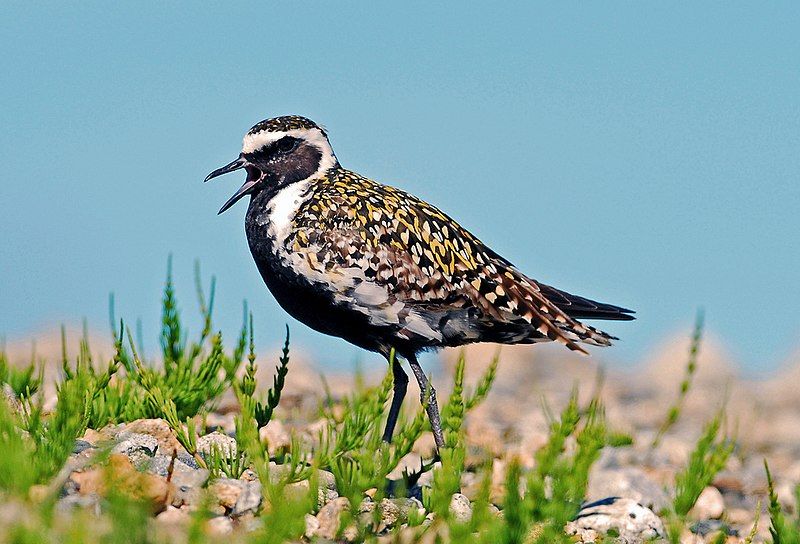
The Pacific golden plover is a migratory shorebird that can be found in Alaska and Siberia during the summertime. It is a medium-sized plover that is capable of long-distance migrations, flying across the Pacific Ocean to other parts of the world during its non-breeding season.
These birds breed during the summer months in Alaska and Siberia, where they find suitable habitats and plenty of food. During their migratory period, they can be spotted in countries like Japan, Australia, New Zealand, and even parts of the United States.
The Pacific golden plover is an important part of the food web, providing essential sustenance to other birds and animals in the region. Its long-distance migrations also help to keep the population of this species healthy and thriving.
| Kingdom | Animalia |
| Phylum | Chordata |
| Class | Aves |
| Order | Charadriiformes |
| Family | Charadriidae |
| Genus | Pluvialis |
| Species | P. fulva |
Conclusion
Birds in Samut Prakan are a diverse and vibrant part of the local ecosystem. They provide a great source of food and entertainment, and many species of birds can be found in the area.
People in Samut Prakan have long appreciated the beauty and variety of birds in their environment, and this appreciation has translated into conservation efforts to protect these birds and their habitats.
With continued efforts to protect and conserve the local bird population, people in Samut Prakan can continue to enjoy the beauty of these birds for many years to come.